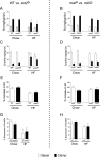Enhanced mitochondrial superoxide scavenging does not improve muscle insulin action in the high fat-fed mouse
- PMID: 25992608
- PMCID: PMC4437982
- DOI: 10.1371/journal.pone.0126732
Enhanced mitochondrial superoxide scavenging does not improve muscle insulin action in the high fat-fed mouse
Abstract
Improving mitochondrial oxidant scavenging may be a viable strategy for the treatment of insulin resistance and diabetes. Mice overexpressing the mitochondrial matrix isoform of superoxide dismutase (sod2(tg) mice) and/or transgenically expressing catalase within the mitochondrial matrix (mcat(tg) mice) have increased scavenging of O2(˙-) and H2O2, respectively. Furthermore, muscle insulin action is partially preserved in high fat (HF)-fed mcat(tg) mice. The goal of the current study was to test the hypothesis that increased O2(˙-) scavenging alone or in combination with increased H2O2 scavenging (mtAO mice) enhances in vivo muscle insulin action in the HF-fed mouse. Insulin action was examined in conscious, unrestrained and unstressed wild type (WT), sod2(tg), mcat(tg) and mtAO mice using hyperinsulinemic-euglycemic clamps (insulin clamps) combined with radioactive glucose tracers following sixteen weeks of normal chow or HF (60% calories from fat) feeding. Glucose infusion rates, whole body glucose disappearance, and muscle glucose uptake during the insulin clamp were similar in chow- and HF-fed WT and sod2(tg) mice. Consistent with our previous work, HF-fed mcat(tg) mice had improved muscle insulin action, however, an additive effect was not seen in mtAO mice. Insulin-stimulated Akt phosphorylation in muscle from clamped mice was consistent with glucose flux measurements. These results demonstrate that increased O2(˙-) scavenging does not improve muscle insulin action in the HF-fed mouse alone or when coupled to increased H2O2 scavenging.
Conflict of interest statement
Figures





References
-
- Kang L, Lustig ME, Bonner JS, Lee-Young RS, Mayes WH, James FD, et al. Mitochondrial Anti-Oxidative Capacity Regulates Muscle Glucose Uptake in the Conscious Mouse: Effect of Exercise and Diet. J Appl Physiol. 2012. Epub 2012/06/02. japplphysiol.01344.2011 [pii] 10.1152/japplphysiol.01344.2011 . - DOI - PMC - PubMed
-
- Motoori S, Majima HJ, Ebara M, Kato H, Hirai F, Kakinuma S, et al. Overexpression of mitochondrial manganese superoxide dismutase protects against radiation-induced cell death in the human hepatocellular carcinoma cell line HLE. Cancer Res. 2001;61(14):5382–8. Epub 2001/07/17. . - PubMed
Publication types
MeSH terms
Substances
Grants and funding
LinkOut - more resources
Full Text Sources
Other Literature Sources
Medical
Molecular Biology Databases
Research Materials
Miscellaneous

